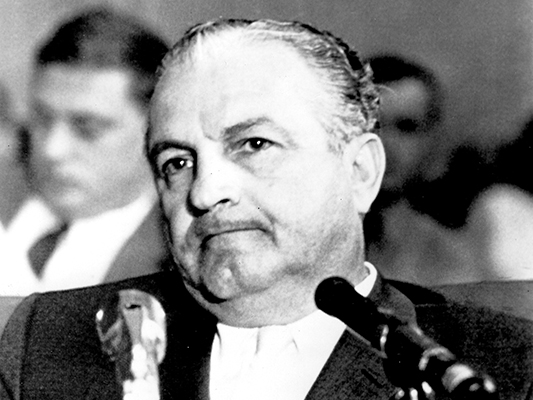Carlos Marcello

Born: February 6, 1910, Tunis, Tunisia
Died: March 2, 1993, Metairie, Louisiana
Nicknames: Little Man
Associations: Matranga’s Black Hand, the Chicago Outfit, the Commission, Santo Trafficante Jr.
Carlos Marcello rose to the top of the venerable New Orleans criminal underground and became an ally of mobsters from across the United States – and not a few politicians along the way.
Marcello, born to a Sicilian family in Tunisia as Calogero Minacori or Minacore, immigrated to Louisiana in 1911. As a youth, Marcello turned to petty crime, especially in the French Quarter, which was also known then as Little Italy.
In New Orleans, Marcello became an associate of one of the oldest Mafia crime syndicates in the United States. Charles and Antonio Matranga founded the New Orleans crime family around 1870. Despite widespread local and national notoriety, the Matranga crime family was able to control various rackets for many decades, including operations on the New Orleans docks, prostitution, narcotics trafficking, gambling and, with the advent of Prohibition, bootlegging.
Charles Matranga resigned the family leadership in 1922 and was replaced by Sam “Silver Dollar” Carolla. Carolla had a variety of legal problems, including busts for narcotics and the shooting death of a federal narcotics agent, in the 1930s. The federal government’s efforts to deport Carolla were delayed by World War II, but in 1947 the government succeeded in deporting him back to Italy.
At that point, his lieutenant, Carlos Marcello, stepped into the top job of the New Orleans Mafia. Marcello was known to the police: He had served nine years on an assault and robbery charge, and had been arrested in 1929 for a bank robbery, although he beat that rap. In 1938, he served less than a year on a marijuana trafficking charge.
Marcello moved into the leadership position with few real challenges, mostly because he made money for everyone. He continued the family policy of working with national mobsters where there would be mutual benefits – a cooperative policy that allowed mobsters from outside Louisiana to come in only with the welcome of the local organization. While outside mobsters weren’t allowed into New Orleans without permission, that didn’t stop Marcello from expanding operations to other areas of the South, notably Dallas, which became effectively an offshoot of his New Orleans operation, and (again in cooperation with other mobsters, notably the Chicago Outfit and the Five Families of New York), South Florida. There, Marcello worked with the boss of the Tampa Mafia, Santo Trafficante Jr. The Tampa and New Orleans Sicilian Mafias had a long and close historical relationship, and the two mobsters were personal friends.
The connections would ultimately lead to speculation, conjecture and conspiracy theories that put Marcello, along with Trafficante and/or Sam Giancana of the Chicago Outfit, in league to assassinate President John F. Kennedy in November 1963. Marcello and his pals had reason to be angry with Kennedy, whom the Mob helped elect but who unleashed his brother, Attorney General Robert Kennedy, in a crusade against organized crime.
Robert Kennedy in particular wanted Marcello’s head because the mobster had managed to avoid serious jail time and had the backing of corrupt state and city government officials.
The Kennedys and Marcello had a history. In 1959, Marcello was called to testify before the Senate’s McClellan Committee on organized crime, which included John F. Kennedy as senator and Robert Kennedy as legal counsel. Marcello, pleading the Fifth Amendment right against self-incrimination, refused to testify. Shortly after Kennedy was sworn in as president, in 1961, Marcello was deported as an undesirable alien to Guatemala, but Marcello made his way back to the United States and his lawyers prevented another deportation.
Enriching the conspiracy theories, Jack Ruby, the strip club operator in Dallas, was an associate of the Marcello and Giancana organizations, and there is no question that Ruby shot and killed the putative assassin, Lee Harvey Oswald, in the Dallas Police headquarters three days after Oswald was arrested. And Oswald himself had an uncle in New Orleans, Charles “Dutz” Murret, who was a well-known associate of the Marcello organization.
There are as many doubters as champions of the Mob-as-assassin conspiracy theories, but the many connections among Marcello, Oswald and Ruby continue to fuel the debates.
In 1966, Marcello served six months of a two-year sentence for assaulting an FBI agent. He managed to avoid the criminal courts for the next 15 years.
Later in life, at age 72, Marcello received two felony convictions. In January 1982, a federal judge sentenced Marcello to seven years in prison for his conviction on one count of conspiracy in the “Brilab” corruption and labor racketeering case. Marcello and other defendants had conspired to accept bribes and kickbacks to provide large state insurance contracts in Louisiana to three salesmen who turned out to be undercover FBI agents conducting a sting operation.
Then, in April 1982, Marcello got an additional 10 years in federal prison for his part in an effort to bribe a federal judge in Los Angeles who was set to preside over a racketeering case to be brought against a number of defendants, including Marcello.
In 1989, the 5th U.S. Circuit Court of Appeals threw out Marcello’s Brilab conviction, and he was released from prison. But he had suffered several strokes and effectively retired from the rackets.
He died at his Metairie, Louisiana, home on March 2, 1993.




